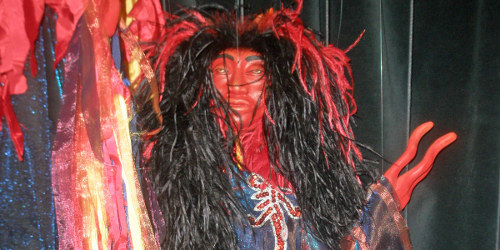By Carolyn Hayes Harmer

How do you tell a story as big as the world? In "Turtle Island," Detroit's PuppetART Theatre incorporates Native American mythology into a parable aimed at showing young viewers how humans are tied both to the natural Earth and to each other. For a tale this rooted in deep interconnectedness, it's fitting that the production overflows with imagination and puppetry concepts that cannot be contained in a single genre or style.
Writer and director Luda Mikheyenko bases the piece on Iroquois legends, beginning with the creation story of the Earth itself. In a sky world high above our own (which designer Irina Baranovskaya manifests in bright rear-projection shadow puppets), a great leader uproots the Tree of Life at the behest of his daughter, who peers into the hole and sees nothing but water far below. But by an iridescent lighting/reflection effect (in concert with front-projection digital imagery by Korey Gozman), the audience sees that water come alive, a vast sea populated with rod puppets of fish, serpents and birds moving in three dimensions.
Movement among the worlds is achieved by pace-setting sound design (audio effects keenly mixed with music, compositions by Robby Gall, and narrative and character voices by Maria Mikheyenko, Steven Andrews, Brandon Will, and Nick Pobutsky), which steps carefully through the story beats, but also pauses to highlight and appreciate the poetry of a school of fish at play. Visually, the puppets (credited to Baranovskaya as well as Igor Kan and Erik Reuland) are colorful and splashy, in keeping with the representative nature of mythological storytelling.
When the Great Leader's daughter slips into the hole left by the Tree of Life and falls slowly downward, the sea creatures notice her descent and fear this Sky Woman cannot live in water alone. They dive deep to retrieve some earth from below, and a turtle volunteers to bear it on his back; this small gesture grows into the Turtle Island on which all humans and land creatures come to live. Again, Baranovskaya changes the storytelling rules as the story dictates, adjusting scrims and backdrops until the space is eventually wide open and the human puppets are visibly manipulated by the veiled, live puppeteers (Nicholas Pobutsky, Connor Ghena, Alexander Trice, and Leslie Wacker).
Budding humanity here takes the form of two brothers, who receive the Sky Woman's gift of the island and life-sustaining fire and then begin to discover themselves and their surroundings. The men are forced to contend with their evolving conceptions of morality and respect as they work with tools to develop shelter, agriculture and hunting skills. Deft work with puppet hands and bodies shows the two infringing on each other's territory and developing a warrior mindset, each against the other. Having strayed from the Sky Woman's mandate for peace, the brothers are punished, but also granted another chance to try again, and again, under the eye of wiser beings than themselves.
The lessons of "Turtle Island" are gentle but insistent, reinforcing that humankind is part of the Earth, on the receiving end of its bounties, and eternally in its debt. This production justifies its view of the natural world as something precious that warrants respect by creating an immersive, imaginative realm well worth respecting. Indeed, the complexity of this presentation and its no-holds-barred approach to visual and audio effects mirrors our actual world, with seemingly countless components required to make it possible, and wonders never ceasing.
REVIEW:
'Turtle Island'
PuppetART
at Detroit Puppet Theater
25 E. Grand River Ave., Detroit
2 p.m. Saturday, Nov. 8, 15, 22, 29
2 p.m. Sunday, Nov. 30
10 a.m. Thursday, Nov. 20
50 minutes; no intermission
$5 children, $10 adults
313-961-7777
http://www.puppetart.org










